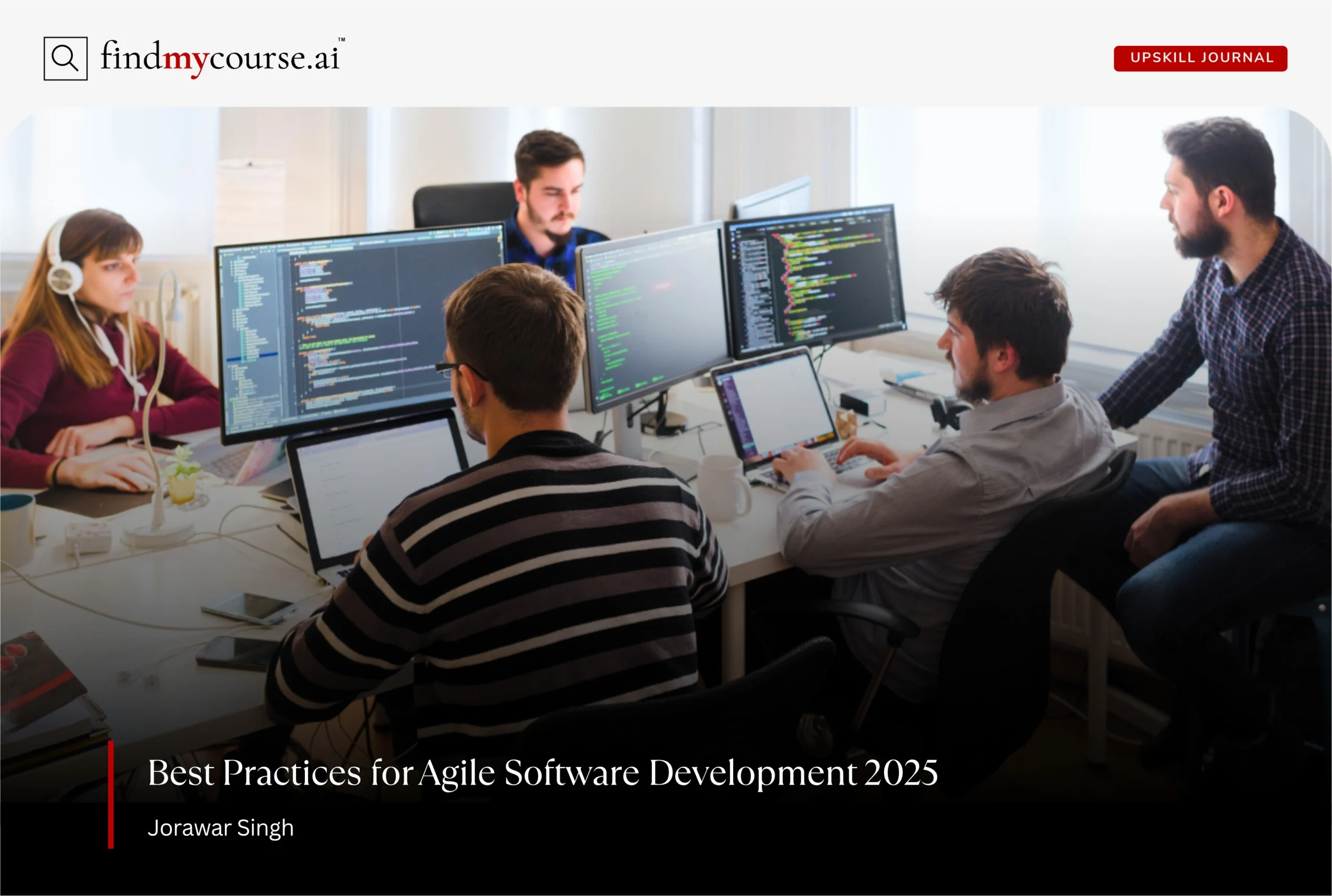In 2025, Agile Software Development is still the leading way to build modern software. Its core values haven’t changed—but the way teams use Agile has. With fast-changing markets, remote work, smart AI tools, and higher user expectations, staying flexible and focused is more important than ever.
This guide covers the best practices for Agile Software Development in 2025. Whether you’re a developer, product manager, or looking to study online, these tips will help you build better software—faster and smarter.
What Is Agile Software Development—and Why It’s Important in 2025
Agile Software Development is a modern way of creating software that focuses on flexibility, teamwork, and continuous improvement. Instead of trying to build everything at once, Agile breaks the work into smaller, manageable pieces. Teams work in short cycles—called sprints—where they plan, build, test, and adjust based on feedback.
Why does this matter in 2025? Because the world of technology moves fast. User expectations change quickly and new tools, trends, and challenges appear all the time. Additionally, agile helps teams stay on track, adapt to change, and keep delivering value without getting stuck in outdated plans.
Therefore, in today’s fast-moving, often remote work environment, Agile gives teams the structure they need—without slowing them down. It’s a smarter, more human way to build great software that meets real needs.
Top 10 Best Practices for Agile Software Development in 2025
Agile is all about staying flexible, delivering value fast, and constantly improving. In 2025, the most successful teams follow modern, human-centered practices that help them stay ahead.
Let’s explore the top 10 shaping Agile Software Development this year:
1. Work Together, Every Day
Agile thrives on strong teamwork—and in 2025, daily collaboration and a clear, well-maintained backlog are more important than ever. Keeping tasks prioritized and easy to understand keeps work flowing without surprises.
What to do:
- Hold short, focused daily stand-ups.
- Involve designers, testers, and business teams early.
- Keep communication open—even for remote teams.
- Review and update the backlog regularly to keep tasks clear, sized right, and well-prioritized.
Why it works:
When everyone stays connected and aligned on priorities, teams make faster decisions, avoid confusion, and stay productive.
2. Deliver in Small, Steady Steps
Agile Software Development in 2025 runs on short, clear cycles—and defining “done” well ensures every step counts. These mini-cycles, called sprints, help teams stay focused and responsive.
What to do:
- Set clear, realistic goals for each sprint.
- Define what “done” means (e.g., code, tests, documentation, etc.).
- Review progress with your team and adjust as needed.
Why it works:
As a result, with smaller steps, it becomes easier to fix problems early, adapt quickly, and deliver real value to users.
3. Use Automation and AI Smartly
Today, smart automation is baked into Agile Software Development. From testing to deployment, the right tools reduce delays and free teams to focus on creativity.
What to do:
- Automate testing, deployments, and server setup.
- Use AI tools to catch bugs, estimate tasks, and improve code.
- Let real-time dashboards help you track project health and team progress.
Why it works:
Less time on routine tasks means more time to focus on innovation, learning, and what users actually need.
4. Test Early and Often
In 2025, testing isn’t something you do last—it’s built into every stage. Including security and accessibility from the start helps avoid costly mistakes later.
What to do:
- Write tests as you code—unit, integration, and UI.
- Include performance and accessibility checks.
- Build security checks into your daily workflow.
Why it works:
By catching bugs early, teams save time, build trust, and move faster with greater confidence.
5. Build a Culture of Learning
Agile teams succeed when they grow together. Moreover, encouraging open feedback, learning time, and space to reflect turns a good team into a great one.
What to do:
- Run regular retrospectives and act on what you learn.
- Encourage curiosity, feedback, and knowledge sharing.
- Create time for team learning and growth. Courses like IBM’s Agile and Scrum Fundamentals on edX help teams understand the “why” behind Agile—and how to do it better together.
Why it works:
Teams that grow together solve problems faster, trust each other more, and stay motivated longer.
6. Focus on Outcomes, Not Just Output
Agile Software Development in 2025 is about real impact—not just shipping more features. Teams succeed when they tie their work to outcomes that matter.
What to do:
- Set sprint goals based on business or user value.
- Track real impact—like user satisfaction or retention—not just how much was delivered.
- Use OKRs (Objectives and Key Results) to stay focused.
Why it works:
When you measure what matters, you spend time on things that make a real difference to customers.
7. Design for Flexibility with Modular Architecture
Agile thrives in environments where systems are easy to change. In 2025, with the help of modular, API-first systems, teams respond faster to change.
What to do:
- Build software with reusable, loosely coupled components.
- Design APIs first to align teams early.
- Use microservices or modular frontends to support faster releases.
Why it works:
Flexible architecture makes your product easier to maintain, test, and scale—without slowing down the team.
8. Use Real Feedback to Guide Development
Agile isn’t about guessing—it’s about learning from users. In 2025, top teams build what people actually want by using real-time data and feedback.
What to do:
- Use analytics, surveys, and A/B tests to learn what’s working.
- Talk to users regularly and observe their behavior.
- Bring user feedback into retrospectives and planning sessions.
Why it works:
When you stop wasting time on features no one wants, you start building what really helps your users.
9. Encourage Skill-Sharing Across the Team
In 2025, Agile teams blur the lines between roles. When people understand different parts of the process, they collaborate better and get more done together.
What to do:
- Pair teammates from different roles (e.g., devs with testers or designers).
- Share knowledge through short demos or learning sessions.
- Switch pair programming partners often to spread knowledge.
Why it works:
Skill-sharing builds empathy and reduces handoffs, which keeps the whole team moving in sync.
10. Make Remote Collaboration Seamless
Remote and hybrid teams are the new normal—and Agile teams must stay connected no matter where they are.
What to do:
- Use tools that support async and real-time collaboration (e.g., video calls, whiteboards, and shared docs).
- Keep meeting times inclusive and communication accessible.
- Make sure remote members are fully included in every Agile ceremony.
Why it works:
When everyone has equal access and voice, the team stays aligned and productive—wherever they’re working from.
Challenges Agile Teams Face in 2025 — and How to Overcome Them
Agile isn’t magic and even the best teams face roadblocks. So, here are some of the most common challenges in 2025:
- Remote miscommunication: Solved by stronger async documentation and inclusive meetings.
- Over-reliance on tools: Balance automation with human insight.
- Scope creep: Prevented by clear sprint goals and strong product ownership.
- Burnout from constant delivery: Build sustainable pacing into your sprint cycles.
Thus, by staying mindful of these challenges, teams can preserve Agile’s flexibility without sacrificing quality or team well-being.
The Future of Agile: Where we’re Headed
In 2025, Agile Software Development is evolving—powered by smarter tools, smoother workflows, and a stronger focus on people. Here’s a quick look at what’s shaping the future:
1. Smarter Planning with AI
AI tools like Jira Product Discovery help teams plan better, sort priorities, and suggest what to build next.
2. DevOps + Agile = One Workflow
With GitHub Actions, teams can build, test, and deploy automatically—streamlining the entire workflow.
3. People-First Culture
Tools like TeamRetro encourage honest feedback and support team well-being through thoughtful retrospectives.
4. Seamless Global Collaboration
Miro makes global teamwork simple with visual boards for sprint planning, brainstorming, and more.
Final Thoughts
Agile Software Development in 2025 isn’t about following rules to the letter—it’s about building with purpose. The best teams today focus less on rigid methods and more on people, outcomes, and learning. When you create room for collaboration, feedback, and growth, great software becomes the natural result. So stay curious, stay flexible, and don’t be afraid to adjust as you go.
And whenever you need clarity, a fresh perspective, or help planning your next step—our AI assistant is just a question away.


